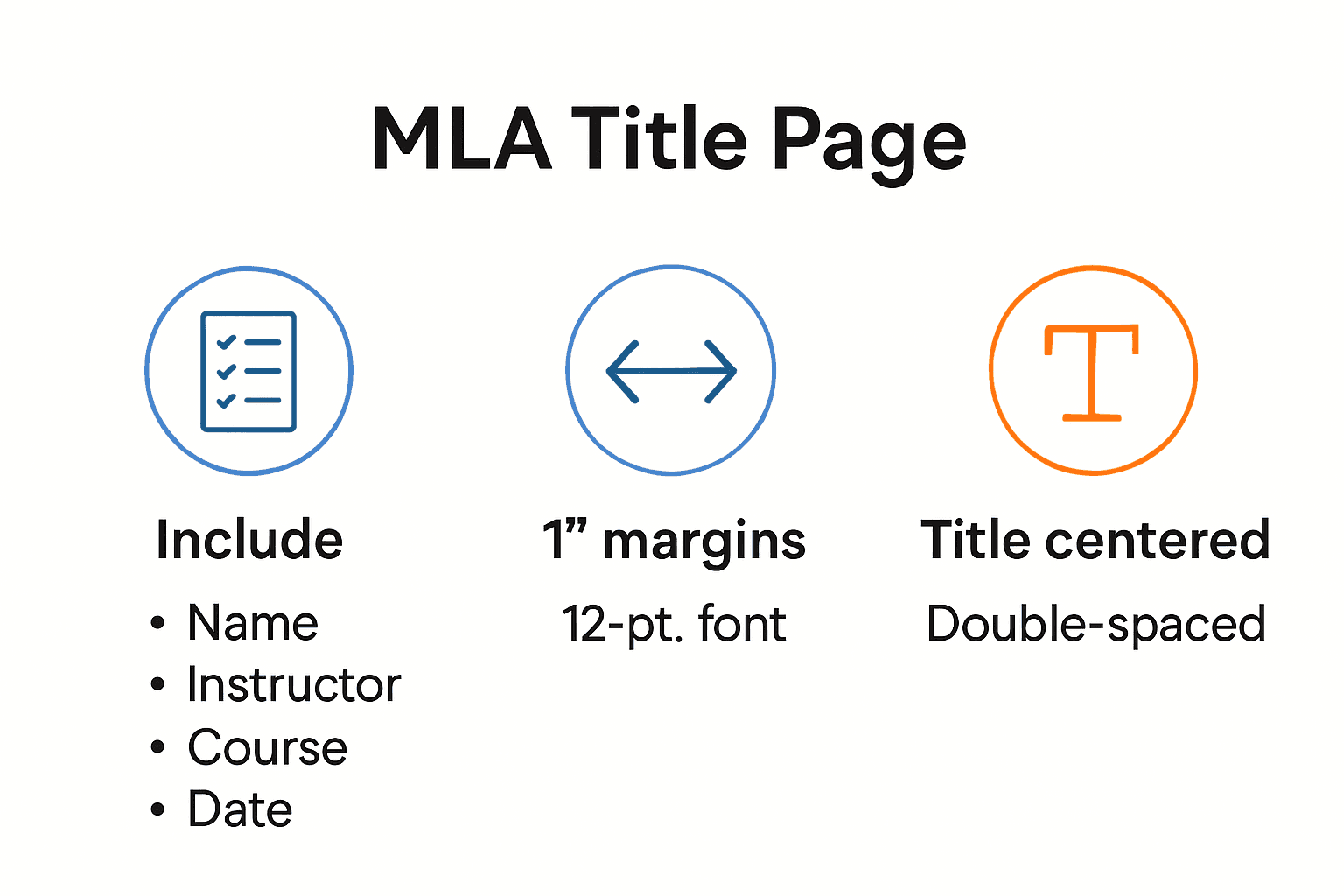Blog
Learning Materials
MLA 스타일로 표지 페이지 형식 지정하기: 2025 학생 가이드
Updated: June 9, 2025

MLA 에세이 제목 페이지는 많은 학생들을 당황하게 만듭니다. 대부분은 복잡한 표지나 특별한 형식을 기대합니다. 놀랍게도, MLA는 대부분의 학술 논문에 대해 별도의 제목 페이지를 요구하지 않습니다. 가장 흔한 오류는 학생들이 과도하게 생각하고 불필요한 장식을 추가하며 가장 중요한 간단한 형식 규칙을 놓치는 데서 발생합니다. 이 예상치 못한 사실을 알면 많은 시간을 절약하고 다른 사람들이 계속 저지르는 실수를 피할 수 있습니다.
목차
빠른 요약
| 요점 | 설명 |
|---|---|
| 별도의 제목 페이지 불필요 | MLA는 대부분의 학술 논문에 대해 별도의 제목 페이지를 요구하지 않으며, 필수 정보는 첫 페이지에 배치해야 합니다. |
| 포함해야 할 주요 정보 | 이름, 강사의 이름, 강좌 제목 및 번호, 제출 날짜를 첫 페이지의 왼쪽 상단에 포함합니다. |
| 올바른 제목 형식 | 제목은 페이지의 약 1/3 지점에 중앙에 배치하며, 표준 대문자 사용을 하되, 굵게, 이탤릭체, 밑줄 형식을 사용하지 않습니다. |
| 피해야 할 일반적인 오류 | 잘못된 페이지 번호 매기기, 부적절한 글꼴 또는 여백 사양과 같은 형식 오류에 주의해야 합니다. 이는 전문성을 떨어뜨릴 수 있습니다. |
| 검토 및 교정 | 이름과 날짜와 같은 세부 사항의 정확성을 항상 두 번 확인하고 문서 전체에 걸쳐 균일한 이중 간격을 유지하십시오. |

MLA 에세이 제목 페이지의 주요 요구 사항
MLA 에세이 제목 페이지의 정확한 요구 사항을 이해하면 학생들이 상당한 시간을 절약하고 잠재적인 형식 오류를 방지할 수 있습니다. 많은 학술 지침이 복잡해 보이지만, MLA 형식은 문서 프레젠테이션에 대해 놀랍도록 간단한 접근 방식을 제공합니다.
표준 MLA 제목 페이지 기대 사항
일반적인 믿음과 달리, 현대 언어 협회(MLA)는 대부분의 학술 논문에 대해 별도의 제목 페이지를 요구하지 않습니다. MLA 인용 지침에 대해 더 알아보기로 문서가 전문 표준을 충족하는지 확인하십시오. 대신, MLA는 논문의 첫 페이지에 필수 식별 정보를 포함하는 간소화된 접근 방식을 권장합니다.
MLA 형식의 기본 요구 사항은 다음과 같습니다:
- 학생 정보: 전체 이름
- 강사 정보: 강사의 이름
- 강좌 정보: 강좌 제목 및 번호
- 제출 날짜: 현재 제출 날짜
이 정보는 첫 페이지의 왼쪽 상단에 표준 12포인트 읽기 쉬운 글꼴(예: Times New Roman)을 사용하여 배치해야 합니다. 문서 전체에 이중 간격을 유지하여 깔끔하고 전문적인 외관을 만듭니다.
구체적인 형식 지침
문서를 준비할 때 여백 사양에 주의하십시오. MLA는 문서의 모든 면에 1인치 여백을 요구합니다. 이 표준은 균형 잡힌 전문적인 외관을 만들어 읽기 쉽고 학술 논문 전반에 걸쳐 일관성을 보장합니다.
논문의 제목은 첫 페이지에 중앙에 배치하고 표준 대문자 사용을 해야 합니다. 제목에 굵게, 이탤릭체, 밑줄 형식을 사용하지 마십시오. 대신, 표준 문장 케이스를 사용하여 주요 단어의 첫 글자를 대문자로 하고 관사와 접속사는 소문자로 유지하십시오.
그룹 프로젝트나 특정 강사의 요구 사항에 따라 별도의 제목 페이지가 필요할 수 있습니다. 이러한 경우, 제목 페이지는 첫 페이지의 형식을 반영하되 페이지 번호는 제외해야 합니다. 이후 페이지에는 오른쪽 상단에 성과 페이지 번호가 포함됩니다.
일반적인 제목 페이지 세부 사항은 다음과 같습니다:
- 논문 제목
- 전체 이름
- 강좌 이름 및 번호
- 강사의 이름
- 제출 날짜
적절한 정렬과 일관된 형식은 학문적 전문성과 세부 사항에 대한 주의를 나타냅니다. 이러한 지침이 세심하게 보일 수 있지만, 이는 학술 글쓰기에서 학문적 정밀성을 나타내는 표준 관행을 나타냅니다.
개별 강사는 이러한 표준 지침에 대한 특정 선호도나 약간의 변형을 가질 수 있음을 기억하십시오. 문서가 모든 지정된 기준을 충족하는지 확인하기 위해 강좌 강사와 정확한 요구 사항을 항상 확인하십시오.
이러한 MLA 에세이 제목 페이지 요구 사항을 이해하고 구현함으로써 학생들은 전문적으로 보일 뿐만 아니라 확립된 학술 글쓰기 표준을 준수하는 문서를 만들 수 있습니다.
제목 페이지 형식화 단계별 가이드
전문적인 MLA 제목 페이지를 만드는 것은 정밀성과 세부 사항에 대한 주의를 요구합니다. 이 과정이 위협적으로 보일 수 있지만, 명확한 단계로 나누면 형식화 도전을 단순화할 수 있습니다. 전문적인 제목 페이지 제작에 대한 포괄적인 가이드 발견하기로 학술 문서가 최고 기준을 충족하도록 하십시오.
문서 설정 준비
형식화를 시작하기 전에 필요한 필수 정보를 수집하십시오. 정확한 여백 및 글꼴 제어를 허용하는 워드 프로세싱 소프트웨어가 있는 컴퓨터를 준비하십시오. 권장 소프트웨어에는 Microsoft Word, Google Docs, 또는 Apple Pages가 포함됩니다.
표준 12포인트 Times New Roman 글꼴을 선택하십시오. 이 글꼴은 학술 글쓰기에서 보편적으로 받아들여지며 뛰어난 가독성을 제공합니다. 문서 설정을 구성하여 모든 면에 1인치 여백을 유지하십시오. 이러한 기술적 준비는 전문적인 외관의 문서를 위한 기초를 만듭니다.
문서 요소 배치
EasyBib의 MLA 형식 지침에 따르면, 제목 페이지는 명확성과 전문성을 강조하는 특정 레이아웃을 따릅니다. 페이지에 텍스트를 수평으로 중앙에 배치하는 것으로 시작하십시오.
첫 페이지의 왼쪽 상단에 개인 정보를 포함하십시오:
- 전체 이름
- 강사의 이름
- 강좌 이름 및 번호
- 제출 날짜
논문의 제목을 페이지의 약 1/3 지점에 표준 제목 케이스 대문자를 사용하여 배치하십시오. 이는 주요 단어의 첫 글자를 대문자로 하고 관사와 접속사는 소문자로 유지하는 것을 의미합니다. 제목을 중앙에 배치하고 굵게, 이탤릭체, 밑줄 형식을 사용하지 마십시오.

최종 형식 확인
제목 페이지를 완료한 후 철저한 검토를 수행하십시오. 모든 텍스트가 이중 간격을 유지하고 일관된 정렬을 유지하는지 확인하십시오. 문서 전체에 걸쳐 글꼴이 일관되게 유지되는지 확인하십시오.
강사가 별도의 제목 페이지를 특별히 요청한 경우, 이 페이지에 번호를 매기지 마십시오. 이후 페이지에는 오른쪽 상단에 성과 페이지 번호가 포함되어야 합니다. 이 미묘한 세부 사항은 MLA 형식 요구 사항에 대한 주의를 나타냅니다.
이러한 지침은 표준이지만, 개별 강사는 특정 선호도를 가질 수 있음을 기억하십시오. 문서가 모든 요구 사항을 완전히 준수하는지 확인하기 위해 강좌 강사와 정확한 요구 사항을 항상 확인하십시오.
이러한 체계적인 단계를 따르면, MLA 형식 표준을 충족할 뿐만 아니라 학문적 작업을 전문적으로 연마하고 정밀하게 제시하는 제목 페이지를 만들 수 있습니다. 이러한 세부 사항에 대한 주의는 학문적 우수성에 대한 헌신을 반영하며 복잡한 형식 지침을 따를 수 있는 능력을 나타냅니다.
일반적인 제목 페이지 실수와 피하는 방법
MLA 제목 페이지 형식의 복잡성을 탐색하는 것은 학생들에게 도전이 될 수 있습니다. 일반적인 함정을 이해하는 것은 전문적이고 학문적으로 수용 가능한 문서를 만드는 데 중요합니다. 완벽한 제목 페이지를 만드는 방법 배우기로 잠재적인 형식 오류를 피하십시오.
형식 및 구조적 오류
많은 학생들이 강사에게 즉시 비전문적으로 보일 수 있는 중요한 실수를 저지릅니다. 가장 빈번한 오류 중 하나는 잘못된 페이지 번호 매기기입니다. EasyBib의 MLA 형식 지침에 따르면, 제목 페이지에는 페이지 번호가 포함되지 않아야 합니다. 학생들은 종종 실수로 페이지 번호를 추가하여 점수 감점으로 이어질 수 있습니다.
또 다른 중요한 실수는 글꼴 및 여백 사양과 관련이 있습니다. 일부 학생들은 비표준 글꼴을 사용하거나 1인치 여백을 유지하지 못합니다. 이러한 사소한 세부 사항은 전체 문서의 전문적인 외관을 손상시킬 수 있습니다. 항상 12포인트 Times New Roman을 사용하고 모든 면에 일관된 1인치 여백을 유지하십시오.
대문자 사용 및 텍스트 표현
제목 대문자 사용은 또 다른 일반적인 걸림돌입니다. MLA 형식은 많은 학생들이 간과하는 특정 대문자 사용 규칙을 요구합니다. 제목의 주요 단어의 첫 글자를 대문자로 하고, 관사와 접속사는 소문자로 유지하십시오. and, of, in과 같은 단어는 제목의 첫 단어가 아닌 한 소문자로 유지해야 합니다.
잘못된 정보 배치는 또 다른 빈번한 오류입니다. 개인 정보는 전략적으로 왼쪽 상단에 배치하고, 제목은 페이지의 약 1/3 지점에 중앙에 배치해야 합니다. 잘못된 정렬이나 배치는 문서를 비전문적으로 보이게 하고 세부 사항에 대한 주의가 부족하다는 인상을 줄 수 있습니다.
내용 및 제출 준비
형식화 외에도 내용 관련 실수는 제목 페이지의 효과를 저해할 수 있습니다. 제출된 모든 정보가 정확하고 최신인지 확인하십시오. 강사의 이름, 강좌 세부 사항, 제출 날짜의 정확성을 두 번 확인하십시오.
일부 학생들은 불필요한 장식 요소를 포함하거나 제목에 굵게 또는 이탤릭체와 같은 부적절한 형식을 사용하는 실수를 저지릅니다. MLA 지침은 단순함과 명확성을 강조합니다. 제목은 깔끔하고 중앙에 배치되며 문서의 나머지 부분과 동일한 글꼴이어야 합니다.
종종 간과되는 중요한 측면은 교정입니다. 오타나 일관되지 않은 간격은 즉각적인 부정적인 인상을 줄 수 있습니다. 제목 페이지를 여러 번 검토하고, 가능하면 새로운 시각으로 보거나 동료에게 검토를 요청하십시오.
이러한 지침이 엄격하게 보일 수 있지만, 이는 전문적인 학문적 표준을 나타냅니다. 각 세부 사항은 학문적 우수성에 대한 헌신과 정확한 지침을 따를 수 있는 능력을 반영합니다. 강사들은 종종 제목 페이지를 학생의 세부 사항에 대한 주의와 학문적 엄격성에 대한 초기 평가로 사용합니다.
이러한 일반적인 실수를 이해하고 피함으로써, MLA 형식 요구 사항을 충족할 뿐만 아니라 학문적 정밀성과 전문성을 보여주는 제목 페이지를 만들 수 있습니다.
전문적인 MLA 제목 페이지를 위한 전문가 팁
전문적인 MLA 제목 페이지를 만드는 것은 기본 지침을 따르는 것 이상을 요구합니다. 이는 학문적 프레젠테이션에 대한 미묘한 이해와 세부 사항에 대한 주의를 요구합니다. MLA 글쓰기 우수성을 위한 포괄적인 가이드 탐색하기로 학문적 문서를 전문 표준으로 끌어올리십시오.
전략적 형식 기법
전문적인 학문적 글쓰기는 단순한 준수를 넘어섭니다. EasyBib의 MLA 형식 지침에 따르면, 가장 효과적인 제목 페이지는 정밀성과 의도성을 보여줍니다.
디지털 형식 도구를 신중하게 고려하십시오. 픽셀 단위의 여백 및 간격 제어를 허용하는 워드 프로세싱 소프트웨어를 사용하십시오. Microsoft Word와 Google Docs는 정확한 MLA 사양을 달성하는 데 도움이 되는 강력한 형식 옵션을 제공합니다. 소프트웨어가 일관된 1인치 여백을 유지하고 정확한 텍스트 배치를 허용하는지 확인하십시오.
여백에 특별한 주의를 기울이십시오. 제목을 페이지의 약 1/3 지점에 배치하는 전략은 임의적이지 않습니다. 이 배치는 시각적 균형을 만들고 전문 문서 디자인에 대한 이해를 보여줍니다. 텍스트를 중앙에 배치하는 것은 깔끔하고 대칭적인 외관을 만들기 위해 신중한 정렬이 필요합니다.
타이포그래피 및 표현의 미묘함
타이포그래피는 전문적인 인상을 만드는 데 중요한 역할을 합니다. 12포인트 Times New Roman이 표준이지만 실제 구현이 중요합니다. 일관된 글꼴 두께를 유지하고 부주의를 암시할 수 있는 변형을 피하십시오.
이중 간격은 기술적 요구 사항 이상입니다. 이는 줄 사이에 여유 공간을 만들어 가독성을 높이고 학문적 명확성에 대한 헌신을 나타냅니다. 문서 전체, 특히 제목 페이지에서 일관된 이중 간격을 유지하는 데 세심한 주의를 기울이십시오.
대문자 사용은 미묘한 전문성을 요구합니다. 제목의 주요 단어의 첫 글자를 대문자로 하고, 관사와 짧은 접속사는 소문자로 유지하십시오. 이 미묘한 접근 방식은 MLA의 정교한 언어 규칙에 대한 이해를 보여줍니다.
고급 준비 및 검토 전략
제목 페이지에 대한 체계적인 검토 프로세스를 개발하십시오. 기본 형식 요구 사항을 넘어서는 개인 체크리스트를 만드십시오. 다음 항목을 포함하십시오:
- 강사의 정확한 이름 철자 확인
- 현재 강좌 제목 및 번호 확인
- 제출 날짜의 정확성 두 번 확인
- 일관된 글꼴 및 간격 보장
동료나 학문적 멘토에게 제목 페이지를 검토하도록 고려하십시오. 외부 관점은 놓칠 수 있는 미묘한 형식 문제를 잡아낼 수 있습니다. 많은 학생들은 새로운 시각이 자신이 놓친 형식의 미묘함을 식별할 수 있음을 발견합니다.
제목 페이지는 단순한 형식 요구 사항 이상입니다. 이는 전문적인 인상을 남길 수 있는 첫 번째 기회입니다. 각 세부 사항은 학문적 규율, 정밀성에 대한 주의, 학문적 관습에 대한 존중을 전달합니다.
이러한 전문가 팁을 마스터하면 제목 페이지가 단순한 행정 문서에서 학문적 전문성의 진술로 변모합니다. 이러한 정교한 전략을 이해하고 구현함으로써, 기술적 준수뿐만 아니라 학문적 커뮤니케이션 표준에 대한 깊은 존중을 보여줍니다.
자주 묻는 질문
MLA는 에세이에 별도의 제목 페이지를 요구합니까?
MLA 형식은 대부분의 학술 논문에 대해 별도의 제목 페이지를 요구하지 않습니다. 대신, 필수 정보는 에세이의 첫 페이지에 포함됩니다.
MLA 에세이의 첫 페이지에 포함해야 할 정보는 무엇입니까?
첫 페이지에는 이름, 강사의 이름, 강좌 제목 및 번호, 제출 날짜가 포함되어야 하며, 모두 왼쪽 상단에 배치됩니다.
MLA 에세이 제목 페이지에서 제목을 어떻게 형식화해야 합니까?
제목은 페이지의 약 1/3 지점에 중앙에 배치하고, 굵게, 이탤릭체, 밑줄 없이 표준 대문자 사용을 해야 합니다.
MLA 제목 페이지를 만들 때 피해야 할 일반적인 실수는 무엇입니까?
일반적인 실수로는 잘못된 페이지 번호 매기기, 부적절한 글꼴 또는 여백 사양, 대문자 사용 오류가 있습니다. 항상 MLA 형식 지침을 준수하는지 두 번 확인하십시오.
스마트 AI 지원으로 MLA 형식 스트레스 제거하기
MLA 제목 페이지에서 세부 사항을 놓치거나 간단한 형식 오류로 인해 점수를 잃은 적이 있다면, 당신만 그런 것이 아닙니다. 전 세계의 학생들이 제목의 정확한 배치, 적절한 대문자 사용, 그리고 점수에 큰 영향을 미치는 작은 간격 규칙에 어려움을 겪고 있습니다. 단계별 가이드가 있어도, 수동 조정은 실수의 지뢰밭처럼 느껴질 수 있습니다. 여백, 글꼴 선택, 인용 구조를 다시는 두 번 생각하지 않는다고 상상해 보십시오.

Samwell.ai가 지루한 부분을 처리하게 하십시오. 우리의 AI 기반 도구는 MLA 지침을 정확하게 적용하고 인간이 자주 놓치는 문제를 플래그할 수 있습니다. 모든 학문적 프로젝트에서 좌절에서 자신감으로 전환하십시오. Samwell.ai를 방문하여 형식을 자동화하고, 완벽한 제목 페이지를 만들고, 교수님을 감동시킬 수 있는 연마된 작업을 제출하십시오. 오늘 학문적 글쓰기를 통제하고 전문성의 새로운 기준을 설정하십시오.
추천 기사
Generate essays with Samwell.ai
Whether you’re a publisher, professor, journalist, or student, let us tailor a plan just for you.가장 많이 읽은 기사

과제 작성을 위한 성공 가이드
에세이 작성을 위한 전문가 팁: 논리를 구성하는 방법부터 에세이 구조를 효과적으로 구축하는 방법까지.

글쓰기 기술: 글쓰기 전략 숙달
전문가의 조언을 받아 에세이 작성을 풍부하게 하세요. 분석, 논문 제시, 효과적인 구조화를 포함합니다.

전문가의 조언을 받아 비판적 반성 에세이를 작성하는 방법
전문가 팁: 비판적 반성 에세이를 작성하는 방법. 구조화하는 방법, 주제를 선택하는 방법, 그리고 증거를 효과적으로 사용하는 방법을 배워보세요.

효과적인 서론을 작성하는 방법: 단계별 가이드
우리의 가이드와 함께 매혹적인 소개를 만드는 예술을 마스터하세요. 잊을 수 없는 인상을 남기는 흥미로운 시작을 만드세요.
